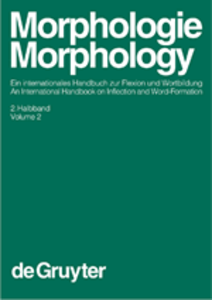Gender and noun class
Aikhenvald, Alexandra (2004) Gender and noun class. In: Booij, Geert, Lehmann, Christian, Mugdan, Joachim, and Skopetas, Stavros, (eds.) Morphology: an international handbook on inflection and word-formation. Walter de Gruyter, Berlin, Germany, pp. 1031-1045.
![[img]](https://researchonline.jcu.edu.au/9063/2.hassmallThumbnailVersion/9063_Aikhenvald_2004_cover.gif)
|
Image (GIF) (cover)
Download (7kB) |
|
|
PDF (Published version)
Restricted to Repository staff only |
Abstract
The term gender was first used in the 5th century B.C. by the Greek philosopher Protagoras, when he divided Greek nouns into three classes: 'feminine', 'masculine', and 'inanimate' (nowadays called "neuter"). This was a typical gender system, which is found in many Indo-European languages. Latin had a similar system, but during historical change neuter nouns were redistributed between the other two genders, giving the modern system of masculine and feminine in French and Italian.
When Europeans came to study African languages, they discovered larger gender-like systems with eight or more possibilities in languages like Swahili; these often did not include a masculine - feminine distinction. The term "noun class" came to be used for systems of this type.
Noun class and gender are often used interchangeably. To avoid confusion, I shall just use the term "gender" in this article.
Since gender systems show some correlation with sex, many non-linguists (and a few linguists) erroneously confuse gender and sex. However, sex represents biological categorization, and gender represents grammatical categorization. Feminine and masculine genders often include inanimate nouns with no connection to female or male sex, e.g. French maison "house' (feminine), chateau 'castle' (masculine).
The terms "gender" and "noun class" have also been used in quite different ways. For instance, in the Athapaskan linguistic tradition the term "gender" is used to refer to verbal classifiers which mark agreement with intransitive subject or transitive object, and characterize the referent noun in terms of shape and form (Aikhenvald 2000: 15).
| Item ID: | 9063 |
|---|---|
| Item Type: | Book Chapter (Research - B1) |
| ISBN: | 978-3-11-017278-2 |
| Additional Information: | German title: Morpholgie: Ein internationales Handbuch zur Flexion und Wortbildung |
| Date Deposited: | 21 Jul 2010 02:12 |
| FoR Codes: | 20 LANGUAGE, COMMUNICATION AND CULTURE > 2004 Linguistics > 200407 Lexicography @ 100% |
| SEO Codes: | 95 CULTURAL UNDERSTANDING > 9502 Communication > 950201 Communication Across Languages and Culture @ 100% |
| Downloads: |
Total: 106 Last 12 Months: 9 |
| More Statistics |



